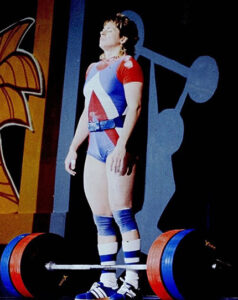
Karyn Marshall Prepares Her Mind To Make History
Acquiring the proper mental attitude and focus are two of the biggest keys to success in weightlifting, not to mention other areas of life. The remarkable story of how Karyn Marshall used those keys to become the first woman in history to C&J more than 300 lb. should be an inspiration to everyone in our sport.
When Karyn began her weightlifting career there was no women’s Weightlifting competition at the Olympic Games, no women’s World’s Championships, no women’s National Championships and no women’s bars. In the US, women could participate in most local weightlifting competitions, but they had to compete simply as weightlifters, with no consideration given to their gender. This was partially because, until the 1970s, most women expressed no interest in participating in Weightlifting.
Yet, encouraged by her soon to be first husband, Tom Tartar (who was already competing and weightlifting and powerlifting) and her first coach, Mark Chasnov, Karyn trained steadily, learned how to lift and got stronger.
In 1981, a few years after Karyn had begun training and competing in local weightlifting events, the first Women’s National Championships in the US were organized by USA Weightlifting (then called the United States Weightlifting Federation). Karyn entered the competition, and her years of training paid off. She won her bodyweight category at that first Nationals. It was the first of the nine National Championships she would ultimately win.
She improved her performance the second year the Women’s Nationals were held, and won with much bigger lifts than she had done in her first year at the Nationals. She and many of her fellow lifters were beginning to feel pretty proud of their performances, and about the growth that was occurring in women’s lifting across the US. And they were happily chatting about that at the Championships.
But one of the coaches present at the meet, Mark Lemenager, who’d overheard one of those discussions, said that the women shouldn’t feel too proud of their performances until someone lifted more than any other woman ever had. He then mentioned that Katie Sandwina, who was credited by many authorities with a 130 kg. (286 lb.) C&J about 75 years earlier. The best of the female lifters in the US were about 25 kg. shy of Katie’s lift at that time.
Karyn and many of the others were surprised, to say the least, when they heard the coach’s comment, as none of them had ever heard of Katie, or the lift she was credited with by some. There were historians said Katie’s lift was actually a Continental and Jerk (in which the bar could be raised to the shoulders in two or more stages, instead of shouldering it in one motion, as in done in a conventional clean). Some experts even claimed Katie’s best performance was closer to 120 kg. than 130 kg. But in any case her best lift was much higher than anyone had done at the US Women’s Nationals thus far, or anywhere else in the world, as far as we knew.
While some doubted Sandwina’s accomplishments. or were a little discouraged to learn someone else had lifted much more than them, Karyn had entirely different reaction – the kind all true champions have.
She wasn’t deflated by word of Katie’s performance, rather she was inspired by it. She became determined to beat Katie’s highest claimed record by lifting 130.5 kg. or more. And Karyn began training with a vengeance to accomplish that goal.
Over time, she increased her bodyweight, and her strength even more substantially, while at the same time honing her technique. As she continued to improve, her burning desire to succeed in her quest for the heaviest C&J ever grew even stronger.
She improved by leaps and bounds and by 1985 she was out lifting every other woman in the US by a comfortable margin. However, her mind was still focused in beating Sandwina’s record. But there was a problem.
While the US recognized women’s US records in Weightlifting, the IWF (the governing body for the sport of Weightlifting worldwide) did not recognize women’s world records. What to do? How could Karyn assure that if she outlifted Sandwina’s record it would be recognized as a World Record, instead of just an American Record?
Ever resourceful, Karyn contacted the folks at the Guinness Book Of World Records to see what they would require to recognize her lift if she bested Katie’s record. They explained their requirements and knowing exactly what she had to do fueled Karyn’s desire for the record even more.
By Feburary of 1986, she was ready to try it. She had arranged for a certified scale to weigh the record, for three international level weightlifting officials to judge her lift and for an international caliber barbell to be used, meeting all of Guinness’s requirements (substantially what the IWF required to recognize a men’s record at the time).
I was honored to handle Karyn’s coaching on the day of her historic attempt, and she came through as hoped, successfully lifting 131 kg. and proudly holding it overhead. She actually tried to break the 300 lb. (136 kg.) barrier for the first time that same day, but I think she was a little tired from the excitement of breaking Katie’s record that day, so she was unable to complete that attempt. Nevertheless, It was a historic day for Karyn, and for women’s weightlifting, in the US and worldwide.
As icing on the cake, Karyn competed in the NY State Championship on March 3 of the same year, where she did succeed with a C&J of 137.5 kg. (approximately 303 lb.) for the first time. In so doing, she became the first woman in weightlifting history to lift more than 300 lb. officially.
In weightlifting, as in many other sports, records are made to be broken. But there is only one first. And being the first to lift more than 300 lb. overhead is an honor that only Karyn will ever be able to claim. It will always stand as a tribute to her courage and persistence.
It all started with a challenge and a person who believed that challenge could be met. One who not only dreamed of success but who had the drive to train as needed to realize her goal.
Karyn went on to break many other barriers, like becoming the first female lifter from the USA ever to win an overall World Weightlifting Championship, at the IWF’s first Women’s World Championships in 1987. At that competition, she lifted more than every other woman in every other bodyweight category, even though she lifted in the 82.5 kg. category that day.
Karyn’s mental attitude – which combined clear goals, a burning desire to succeed with courage and confidence, fueled her success, as did a deep mental focus. We urge you to use the same tools to achieve your own weightlifting success.
A Post Script on Mental Attitude – Bob Hoffman’s Advice
While many in the Weightlifting community today have never heard of Bob Hoffman, they should know that he did more to popularize that sport in the US (and arguably even worldwide) than anyone else in history.
He also coached the three most successful Olympic Weightlifting Teams in US history – in 1948, when US athletes won four gold, three silver and a bronze medal, in 1952, when the US won four gold, two silver medals, and in 1956, when US athletes won four gold, two silver and one bronze medal (this in an era when there were only seven bodyweight categories and no women’s competition). Bob also made contributions to the medals US athletes won in 1936, 1960, 1964, 1968, 1972 and 1976.
As the coach with the greatest record of coaching World and Olympic Champion athletes in US history, and one of the best in the history of sport worldwide, Bob was often asked by aspiring athletes “What do I have to do to become an Olympic Champion?”. He always offered the following two-part response: “You gotta wanna” and “weightlifting must be first in your life”.
Explained more broadly (as Bob often went on to do – and I heard him do it), you have to start with a burning desire to be a great weightlifter, a desire so strong that it fuels you to take, without hesitation, the actions needed to realize success.
These included learning how to lift properly, training as hard as needed to stimulate strength and power development, sleeping long and well, maintaining a tranquil mind, not dissipating, and eating properly.
On a practical level, the second requirement of putting weightlifting first in your life meant constantly asking yourself, about every material decision you had to make, “Will this help my weightlifting?”. If the answer was yes, you were to move forward with enthusiasm and dispatch.
But if the answer was maybe, you were to question doing it. And if the answer was no (it might or would likely hurt your lifting), you should not do it. Period (or if it was required in the short run, do it only until you could find a suitable alternative).
For instance, if you had a job that was physically or mentally draining you, keeping you from resting, etc. you should be looking for a suitable alternative that would better support your training.
Bob had tons of other advice, which he both disseminated verbally and informally, and/or wrote about over a period of decades, in his magazine Strength and Health. He also provided coaching in person at the York Barbell Company’s gym, where training and coaching were gratis for those invited, and virtually no one was ever turned away.
But of all the things he ever said, his statements about having to want it, and making weightlifting first, were gems that remain really indispensable. They are as true today is there were then, perhaps even more so given the popularity and competitiveness of weightlifting worldwide today.

